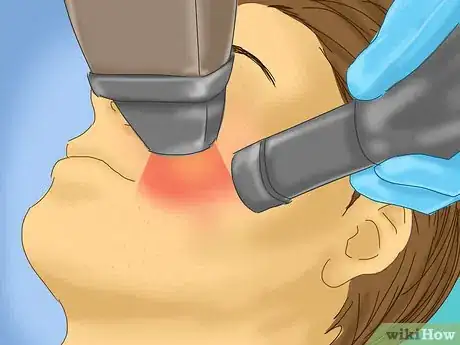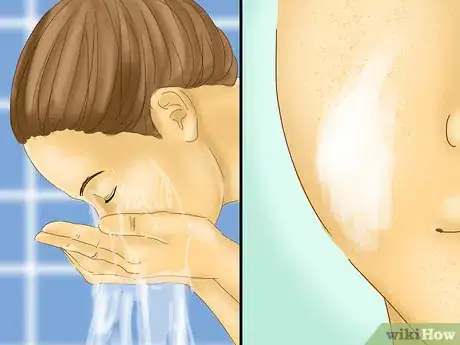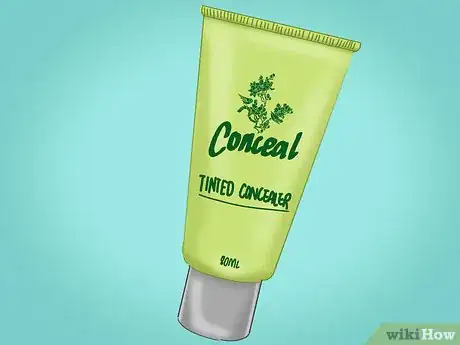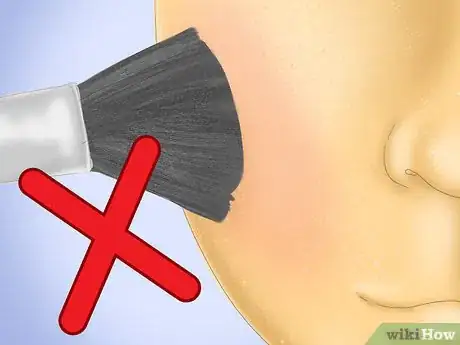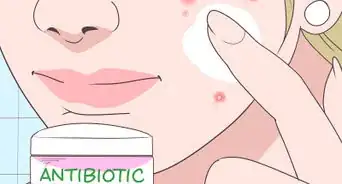This article was co-authored by Lydia Shedlofsky, DO. Dr. Lydia Shedlofsky is a Resident Dermatologist who joined Affiliated Dermatology in July of 2019 after completing a traditional rotating internship at Larkin Community Hospital in Miami, Florida. She earned a Bachelor of Science in Biology at Guilford College in Greensboro, North Carolina. After graduation, she moved to Beira, Mozambique, and worked as a research assistant and intern at a free clinic. She completed a Post-Baccalaureate program and subsequently earned a Master's Degree in Medical Education and a Doctorate of Osteopathic Medicine (DO) from the Lake Erie College of Osteopathic Medicine.
There are 14 references cited in this article, which can be found at the bottom of the page.
This article has been viewed 89,509 times.
If you have a condition called rosacea or just have very rosy cheeks, you know it can be embarrassing at times. Fortunately, you can take some steps to correct the issue with makeup. In addition, if you have rosacea or another medical condition, you can find ways to address the issue medically, as well.
Steps
Getting Rid of Rosy Cheeks Caused by Rosacea
-
1Wash your face twice a day. This step helps remove any irritants from your face, including your makeup, dirt and grime, bacteria, and microorganisms, which can help your skin to heal. Pick a gentle cleanser that is appropriate for your skin type, whether you have oily, dry, or mid-range skin. Most cleansers say what skin type they are designed for.[1]
- After blotting your skin dry, wait half an hour before applying makeup or medication. If you're applying both, put the medication on first and wait an additional 10 minutes before moving on to your makeup, sunscreen, or moisturizer.[2]
-
2Avoid common triggers. Certain foods and situations can cause rosacea to flare. For instance, hot foods, whether through temperature or spiciness, can cause flareups, including soups and hot drinks. In addition, alcohol can be a problem. Heat in many forms can cause irritation, including hot baths, exercise, and hot temperatures. Finally, stress can cause flareups as well.[3] [4]
- Also, skip facial products that use alcohol, as that can irritate your face.[5]
Advertisement -
3Wear sunscreen. Even if you don't have rosacea, sun damage can cause your skin to become thick and leathery over time. If you do have rosacea, the sun can cause your skin to be inflamed.[6] Pick a sunscreen that is SPF 30 or higher, and make sure to apply it every day. Be sure to choose one for sensitive skin.
- You can find moisturizers that have sunscreen built in, which cuts out steps in your morning routine.
-
4
-
5Ask about antibiotics. Antibiotics are a common treatment for rosacea. For a particularly bad flare-up, your doctor may recommend a round of pills. Generally, though, you will use antibiotic creams or lotions to treat this condition.[9]
-
6Discuss acne treatments. Your redness may also be from acne. However, certain acne treatments also help treat rosacea, such as isotretinoin. This drug lessens the appearance of lesions on the face, whether from acne or rosacea.[10]
-
7Ask about light and laser treatments. These treatments can help particularly bad cases of rosacea. Talk to your dermatologist about whether this treatment is viable for you.[11] [12]
- Mainly, these treatments help lessen the appearance of redness and blood vessels. They can also help smooth out leathery skin.[13]
Hiding Rosy Cheeks With Makeup
-
1Clean and moisturize your face. Before you start with makeup, make sure to wash your face first with a gentle cleanser. In addition, use a moisturizer to help keep your skin hydrated.[14]
- It's important to be gentle with your skin, as being rough can make your skin redder or cause rosacea flareups if you have that condition. Try blotting your skin after you wash it instead of rubbing it, for instance, and try to be gentle when washing your face.[15]
-
2Use a primer. Primer acts as a go-between. It protects your skin from the make up, so if your cheeks are rosy from irritation, it can help lessen the effect.[16] A green primer works best to help cover redness.
- Always test any product you plan to use on your face on another area of skin, such as the back of your neck, to see if it will irritate it.[17]
-
3Pick a tinted concealer. Try a concealer with a hint of yellow in it to help hide redness if it's only lightly red. If you need a bit more help or you skin is flaky, opt for a green-tinted moisturizer. If you have a condition such as rosacea, it's important to choose products that are oil-free.[18]
- When adding powdered concealer, a brush is best. It lets you add just as much as you need.[19] Because bacteria can irritate conditions like rosacea, choose brushes that are antibacterial.[20]
- If you use a stick concealer, use it to make small dots where you need it. Gently rub it over the areas to create an even layer.[21]
-
4Use a foundation. The foundation helps even out your face and the concealer. Apply it over your whole face for an even skin tone.[22]
-
5Don't use blush. If you already have redness, you don't need to create more rosiness. Use a base that will let the natural rosiness shine through on your cheeks without looking red or irritated.
References
- ↑ http://www.rosacea.org/patients/skincare/facialcleansing.php
- ↑ http://www.rosacea.org/patients/skincare/facialcleansing.php
- ↑ https://newsinhealth.nih.gov/issue/aug2012/feature2
- ↑ Lydia Shedlofsky, DO. Dermatologist. Expert Interview. 30 September 2020.
- ↑ http://www.mayoclinic.org/diseases-conditions/rosacea/basics/treatment/con-20014478
- ↑ Lydia Shedlofsky, DO. Dermatologist. Expert Interview. 30 September 2020.
- ↑ Lydia Shedlofsky, DO. Dermatologist. Expert Interview. 30 September 2020.
- ↑ http://www.mayoclinic.org/diseases-conditions/rosacea/basics/definition/con-20014478
- ↑ http://www.mayoclinic.org/diseases-conditions/rosacea/basics/treatment/con-20014478
- ↑ http://www.mayoclinic.org/diseases-conditions/rosacea/basics/treatment/con-20014478
- ↑ https://www.aad.org/public/diseases/acne-and-rosacea/rosacea
- ↑ Lydia Shedlofsky, DO. Dermatologist. Expert Interview. 30 September 2020.
- ↑ https://newsinhealth.nih.gov/issue/aug2012/feature2
- ↑ http://www.rosacea.org/patients/skincare/makeuptips.php
- ↑ http://www.rosacea.org/patients/skincare/makeuptips.php
- ↑ http://www.goodhousekeeping.com/beauty/makeup/tips/a32636/conceal-redness-rosacea-with-makeup/
- ↑ http://www.rosacea.org/patients/skincare/makeuptips.php
- ↑ http://www.rosacea.org/patients/skincare/makeuptips.php
- ↑ http://www.goodhousekeeping.com/beauty/makeup/tips/a32636/conceal-redness-rosacea-with-makeup/
- ↑ http://www.rosacea.org/patients/skincare/makeuptips.php
- ↑ http://www.seventeen.com/beauty/makeup-skincare/q-and-a/a2904/red-cheeks/
- ↑ http://www.goodhousekeeping.com/beauty/makeup/tips/a32636/conceal-redness-rosacea-with-makeup/
- ↑ http://www.rosacea.org/patients/skincare/makeuptips.php
- ↑ http://www.cosmopolitan.co.uk/beauty-hair/makeup/a38563/cover-spots-redness-mineral-foundation/







